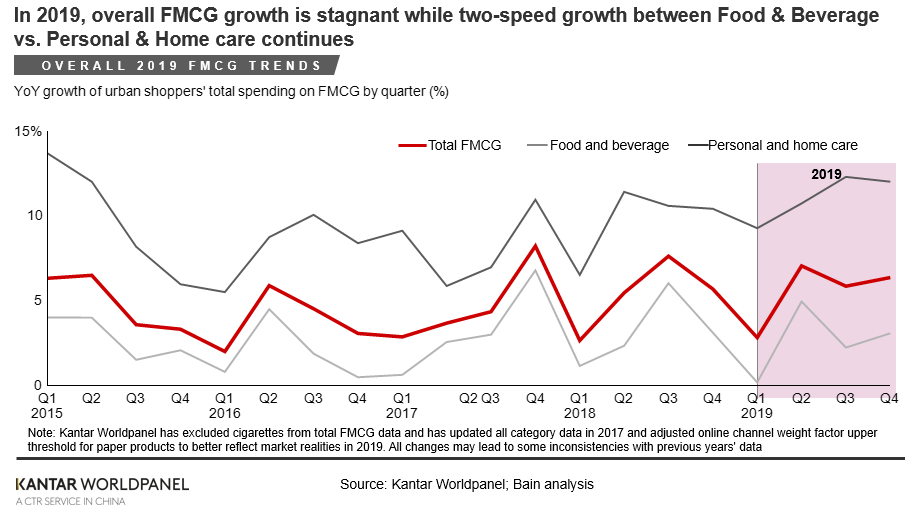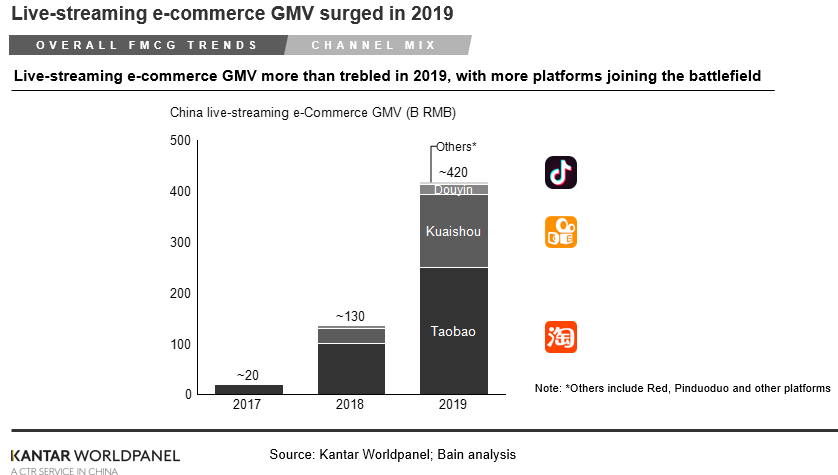Overall, 2019 was a good year for FMCG in China with growth at +5.5%, slightly higher than the previous two years. Some interesting developments included a slowdown in premiumization and growth in the mass segments of several categories. For the first time foreign companies grew faster than their domestic counterparts, 9.5% compared to 7%.
Kantar Worldpanel and Bain & Company’s ninth annual 2020 China Shopper Report Vol 1 reveals that in the first quarter of 2020, consumers spent less because of COVID-19. FMCG spending dropped by 6.7%, the biggest decline on record.

The report has tracked the shopping behaviours of Chinese consumers since 2012, creating a long-term view across 106 FMGC categories purchased for home consumption in China. The report analyzes the key 26 categories that span the four largest consumer goods sectors: packaged food, beverages, personal care and home care. Combined, these sectors represent 80% of all FMCG spending. In 2019 the value of packaged foods rose by 1.9%, beverages grew by 2.9% and, in line with the two-speed pattern, personal care categories grew 11.8% while home care registered 9.4% growth.
E-commerce grew by 35.2% in 2019, largely at the expense of hypermarkets and grocery stores, which declined by 3.4% and 7.2% respectively. Convenience has been a big reason for the shift to online retailing in China. This is reflected in the widespread adoption of online to offline retail (O2O), which now represents 4.3% of total FMCG value share and is playing an increasing role in offline channels. Online channels experienced 19% year-on-year growth during the first quarter of 2020, while offline sales dropped by 13%.
The pandemic has hastened the move to value brands that we identified in 2019 and accelerated the shift to online channels. Consumers, quarantined at home because of the COVID-19 pandemic, had no choice but to buy online, with many opting to continue even after stores opened.
Virtually non-existent three years ago, live streaming sales also more than tripled in 2019 and now account for 4% of total online retail sales and about 1% of total retail sales. The increasing number of online festivals and the steady shift to online also contributed to higher promotion rates for most categories in 2019. This is especially true in the case of personal care, home care and the baby categories. Overall, online sales on promotion grew from 40% to 43% in 2019. Meanwhile, offline sales on promotion remained much lower, at 23%, in the same period.

Brands and retailers will have to learn to navigate the uncertainties presented by a post COVID-19 world as growth will be more difficult to attain for the rest of the year and beyond. The path to recovery will be different for every brand as it depends not only on how the category has been impacted but also how consumer needs will change in the future. It is vital to keep monitoring how consumer purchase behaviors evolve to form a strategy of how to grow in the time of the ‘new normal.’
FMCG categories have reacted to the ongoing COVID-19 pandemic in various ways with recovery taking different shapes:
A first group of categories, including personal wash and soy sauce, boomed during the pandemic and have continued expanding in the recovery. These were widely used in stay-at-home situations. Once restrictions eased, consumers remained focused on health and a desire to pursue at-home activities which continues to strengthen sales.
A second group of categories – frozen food, packaged water and household cleansers - boomed during the lockdown but have since stabilized. Consumers stocked up for the pandemic and had enough on hand after it ended.
A third group endured a V-shaped recovery, with sales of beer, skincare and pet food dropping dramatically during the pandemic, only to recover quickly, as consumers felt the need to re-purchase.
The final group, non-essential categories such as makeup and impulse categories such as candy, declined but are slowly improving in an L/U-shaped recovery.
Facing an uncertain future, brands need to rethink their strategy. Those that closely monitor and re-evaluate the market, industry and consumers spending patterns in the post-COVID economy are better positioned to build a product portfolio with the right value propositions and pricing.
Successful brands must also review their innovation pipeline to accelerate new products relevant in a post-COVID-19 environment and ensure they cover both premium and value segments. Additionally, brands should implement a 4-D approach: Design for China, Decide in China, Deliver at China speed and Digitalize the China business. Channel strategy is key, in particular online, O2O and live streaming in order to build trust and local relevance with China’s consumers.

